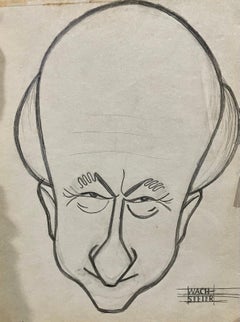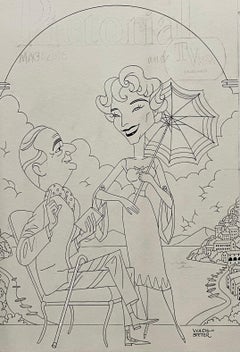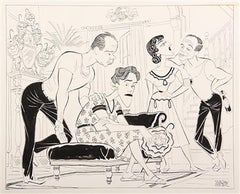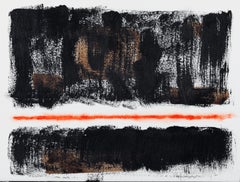George Wachsteter Paintings
to
7
4
5
2
5
2
Overall Height
to
Overall Width
to
7
4
4
3
3
3
2
2
2
1
1
1
1
1
1
5
2
1
2
2
222
901
651
641
610
5
4
3
3
2
Artist: George Wachsteter
The Miss Universe
By George Wachsteter
Located in Fort Washington, PA
Signed Lower Right by Artist
Caricature by George Wachsteter (1911-2004) for the 1965 CBS telecast of 'The Miss Universe' Pageant with hosts Jack Linkletter, June Lockhart, John Dal...
Category
1960s George Wachsteter Paintings
Materials
Watercolor, Ink
Cecil B. DeMille
By George Wachsteter
Located in Fort Washington, PA
Signed Lower Right by Artist
GRAPHITE SKETCHES - Caricature by George Wachsteter (1911-2004) of legendary autocratic motion picture director, Cecil B. DeMille, 8" x 11". 'Fields in ...
Category
21st Century and Contemporary George Wachsteter Paintings
Materials
Graphite
Caricature Cover Design of Maurice Evans and Janice Rule
By George Wachsteter
Located in Fort Washington, PA
Signed Lower Right by Artist
CARICATURE - George Wachsteter (1911-2004) Ink and Pencil on Illustration Board with Color Overlay Caricature Cover Design of Maurice Evans and Janice R...
Category
21st Century and Contemporary George Wachsteter Paintings
Materials
Ink, Watercolor, Ballpoint Pen
'The Lively Ones'
By George Wachsteter
Located in Fort Washington, PA
Signed Lower Right by Artist
PHOTOSTAT ILLUSTRATION & COMP COLOR OVERLAY - Caricature by George Wachsteter (1911-2004) for 1962 NBC-TV variety show 'The Lively Ones' with star & hos...
Category
1960s George Wachsteter Paintings
Materials
Ink, Ballpoint Pen, Color Pencil
Tennis Champion, Don Budge
By George Wachsteter
Located in Fort Washington, PA
Medium: Oil on Canvasboard
Signature: Unsigned
Caricature by George Wachsteter (1911-2004) of Tennis Champion Don Budge, Number One ranked player in the world, 1937-42, injury from ...
Category
1930s George Wachsteter Paintings
Materials
Canvas, Oil, Board
1958 Broadway Drama, "Summer of the 17th Doll"
By George Wachsteter
Located in Fort Washington, PA
Medium: Pen and Ink on Illustration Board
Signature: Signed Lower Right and Upper Left
This piece is on 15.00" x 20.00" illustration board and has a 13.00" x 16.00" image.
Caricatur...
Category
1950s George Wachsteter Paintings
Materials
Ink, Illustration Board, Pen
Composer and Musician Tony Mottola, "Mr. Big, " Author of "Danger"
By George Wachsteter
Located in Fort Washington, PA
Medium: Pen and Ink on Illustration Board
Signature: Signed Upper Right
Caricature by George Wachsteter (1911-2004) of Composer and Musician Tony Mottola, `Mr. Big`, author of the `Danger` chord for the 1950 NBC-TV show of the same name. A famous musical signature where a single repeated note is interrupted by a dramatic chord or sting, the device was named after the series which first utilized it as its theme, the CBS-TV suspense anthology, `Danger` (1950-55). It was one of the directors for `Danger` - Yul...
Category
1950s George Wachsteter Paintings
Materials
Ink, Illustration Board, Pen
Related Items
The Staring Figures
By Max Weber
Located in New York, NY
The Staring Figures by Max Weber (1881-1961)
Ink, pencil, and watercolor on paper
10 ½ x 7 ½ inches unframed (26.67 x 19.05 cm)
16 ½ x 11 ½ inches framed (41.91 x 29.21 cm)
Descript...
Category
20th Century George Wachsteter Paintings
Materials
Pencil, Ink, Watercolor
Thread
By Ed Touchette
Located in Gloucester, MA
Ed Touchette (b. 1948) is inspired by a love of architecture and public spaces to make paintings which express joyful wonder at our built environment — ol...
Category
2010s Bauhaus George Wachsteter Paintings
Materials
Ink, Acrylic, Watercolor
Clown with Birthday Bouquet - Oil and Ink on Cardstock
Located in Soquel, CA
Clown with Bouquet - Acrylic and Ink on Cardstock
Colorful portrait of a clown holding a bouquet of flowers by Jassen Marek (20th Century). A sad clown in a suit with a straw hat ho...
Category
Late 20th Century American Impressionist George Wachsteter Paintings
Materials
Illustration Board, Oil, Pen
H 24 in W 12 in D 0.25 in
The Abduction of the Sabine Women , a Renaissance drawing by Biagio Pupini
Located in PARIS, FR
This vigorous drawing has long been attributed to Polidoro da Caravaggio: The Abduction of the Sabine Women is one of the scenes that Polidoro depicted between 1525 and 1527 on the façade of the Milesi Palazzo in Rome. However, the proximity to another drawing inspired by this same façade, kept at the Ecole des Beaux-Arts, and to other drawings inspired by Polidoro kept at the Musée du Louvre, leads us to propose an attribution to Biagio Pupini, a Bolognese artist whose life remains barely known, despite the abundant number of drawings attributed to him.
1. Biagio Pupini, a Bolognese artist in the light of the Roman Renaissance
The early life of Biagio Pupini, an important figure of the first half of the Cinquecento in Bologna - Vasari mentions him several times - is still poorly known. Neither his date of birth (probably around 1490-1495) nor his training are known. He is said to have been a pupil of Francesco Francia (1450 - 1517) and his name appears for the first time in 1511 in a contract with the painter Bagnacavallo (c. 1484 - 1542) for the frescoes of a church in Faenza. He then collaborated with Girolamo da Carpi, at San Michele in Bosco and at the villa of Belriguardo.
He must have gone to Rome for the first time with Bagnacavallo between 1511 and 1519. There he discovered the art of Raphael, with whom he might have worked, and that of Polidoro da Caravaggio. This first visit, and those that followed, were the occasion for an intense study of ancient and modern art, as illustrated by his abundant graphic production.
Polidoro da Caravaggio had a particular influence on the technique adopted by Pupini. Executed on coloured paper, his drawings generally combine pen, brown ink and wash with abundant highlights of white gouache, as in the drawing presented here.
2. The Abduction of the Sabine Women
Our drawing is an adaptation of a fresco painted between 1525 and 1527 by Polidoro da Caravaggio on the façade of the Milesi Palace in Rome. These painted façades were very famous from the moment they were painted and inspired many artists during their stay in Rome. These frescoes are now very deteriorated and difficult to see, as the palace is in a rather narrow street.
The episode of the abduction of the Sabine women (which appears in the centre of the photo above) is a historical theme that goes back to the origins of Rome and is recounted both by Titus Livius (Ab Urbe condita I,13), by Ovid (Fasti III, 199-228) and by Plutarch (II, Romulus 14-19). After killing his twin brother Romus, Romulus populates the city of Rome by opening it up to refugees and brigands and finds himself with an excess of men. Because of their reputation, none of the inhabitants of the neighbouring cities want to give them their daughters in marriage. The Romans then decide to invite their Sabine neighbours to a great feast during which they slaughter the Sabines and kidnap their daughters.
The engraving made by Giovanni Battista Gallestruzzi (1618 - 1677) around 1656-1658 gives us a good understanding of the Polidoro fresco, allowing us to see how Biagio Pupini reworked the scene to extract this dynamic group.
With a remarkable economy of means, Biagio Pupini takes over the left-hand side of the fresco and depicts in a very dense space two main groups, each consisting of a Roman and a Sabine, completed by a group of three soldiers in the background (which seems to differ quite significantly from Polidoro's composition).
The balance of the drawing is based on a very strongly structured composition. The drawing is organised around a median vertical axis, which runs along both the elbow of the kidnapped Sabine on the left and the foot of her captor, and the two main diagonals, reinforced by four secondary diagonals. This diamond-shaped structure creates an extremely dynamic space, in which centripetal movements (the legs of the Sabine on the right, the arm of the soldier on the back at the top right) and centrifugal movements (the arm of the kidnapper on the left and the legs of the Sabine he is carrying away, the arm of the Sabine on the right) oppose each other, giving the drawing the appearance of a whirlpool around a central point of support situated slightly to the left of the navel of the kidnapper on the right.
3. Polidoro da Caravaggio, and the decorations of Roman palaces
Polidoro da Caravaggio was a paradoxical artist who entered Raphael's (1483 - 1520) workshop at a very young age, when he oversaw the Lodges in the Vatican. Most of his Roman work, which was the peak of his career, has disappeared, as he specialised in facade painting, and yet these paintings, which are eminently visible in urban spaces, have influenced generations of artists who copied them abundantly during their visits to Rome.
Polidoro Caldara was born in Caravaggio around 1495-1500 (the birthplace of Michelangelo Merisi, known as Caravaggio, who was born there in 1571), some forty kilometres east of Milan. According to Vasari, he arrived as a mason on the Vatican's construction site and joined Raphael's workshop around 1517 (at the age of eighteen according to Vasari). This integration would have allowed Polidoro to work not only on the frescoes of the Lodges, but also on some of the frescoes of the Chambers, as well as on the flat of Cardinal Bibiena in the Vatican.
After Raphael's death in 1520, Polidoro worked first with Perin del Vaga before joining forces with Maturino of Florence (1490 - 1528), whom he had also known in Raphael's workshop. Together they specialised in the painting of palace façades. They were to produce some forty façades decorated with grisaille paintings imitating antique bas-reliefs.
The Sack of Rome in 1527, during which his friend Maturino was killed, led Polidoro to flee first to Naples (where he had already stayed in 1523), then to Messina. It was while he was preparing his return to the peninsula that he was murdered by one of his assistants, Tonno Calabrese, in 1543.
In his Vite, Vasari celebrated Polidoro as the greatest façade decorator of his time, noting that "there is no flat, palace, garden or villa in Rome that does not contain a work by Polidoro". Polidoro's facade decorations, most of which have disappeared as they were displayed in the open air, constitute the most important lost chapter of Roman art of the Cinquecento. The few surviving drawings of the painter can, however, give an idea of the original appearance of his murals and show that he was an artist of remarkable and highly original genius.
4. The façade of the Milesi Palace
Giovanni Antonio Milesi, who commissioned this palace, located not far from the Tiber, north of Piazza Navona, was a native of the Bergamo area, like Polidoro, with whom he maintained close friendly ties. Executed in the last years before the Sack of Rome, around 1526-1527, the decoration of Palazzo Milesi is considered Polidoro's greatest decorative success.
An engraving by Ernesto Maccari made at the end of the nineteenth century allows us to understand the general balance of this façade, which was still well preserved at the time. The frescoes were not entirely monochrome, but alternated elements in chiaroscuro simulating marble bas-reliefs and those in ochre simulating bronze and gold vases...
Category
16th Century Old Masters George Wachsteter Paintings
Materials
Ink, Gouache, Pen
'Story Time', Paris, Salon d'Automne, New York, ASL, Corcoran, PAFA, Art Deco
By Nura Ulreich
Located in Santa Cruz, CA
Signed lower left 'Nura' for Nura Woodson Ulreich (American, 1899–1950). Additionally signed, verso, dated March 1928 with artist's New York City ...
Category
1920s Surrealist George Wachsteter Paintings
Materials
Oil, Illustration Board
H 20 in W 16 in D 0.25 in
Grass Eight, botanical, green yellow landscape
Located in Petaluma, CA
This painting is part of my Grass Series. I've been working on landscape and botanical imagery for the two years. My goal is to create color fields that are slightly abstract yet ca...
Category
21st Century and Contemporary Contemporary George Wachsteter Paintings
Materials
Oil, Acrylic, Graphite
Girl playing the flute oil painting
Located in Barcelona, Barcelona
Enrique Montserrat Foj (1935-2022) - Girl playing the flute - Oil
Oil on canvas glued to cardboard.
Oil measures 46x38 cm.
Frameless.
Romantic cartoonist, especially for the foreign market, and also a gymnast.
Cartoonist linked to Editorial Bruguera and its agency Creaciones Editoriales. She got her start drawing girls' or adventure comics in Stories and the Sissi Graphic Novel Supplement. Much of her work from the 1960s was aimed at the European market for young women's magazines through the Selecciones Ilustradas agency. Anecdotally, he collaborated with Marvel Comics, drawing a romantic comic based on a script by Stan Lee for the title My Love (later republished in Our Love Story), credited there as Enrique Monserratt.
He retired from comics in the 1980s to focus on painting.
He was also an Olympic gymnast, a member of the Barcelona Gymnastics Center and the Barcino Tennis Club. He was champion of Spain in the third category (1955) and third in the Spanish Artistic Gymnastics Championships (1961). He participated in the Mediterranean Games (1959) and in the Rome Olympic...
Category
1980s Impressionist George Wachsteter Paintings
Materials
Cardboard, Oil, Canvas
'Ebren Ha Dor, Tremenus'. Framed contemporary landscape, rural sky blue nature
By Sophia Milligan
Located in Penzance, GB
'Ebren Ha Dor, Tremenus'. Contemporary landscape painting, Cornwall
Original Artwork. Framed ready to hang
_________________
The dancing light and rapidly changing skies, hung high a...
Category
2010s Contemporary George Wachsteter Paintings
Materials
Watercolor, Handmade Paper, Ink
Catalan peasant oil on canvas painting spanish
By Luis Graner Y Arrufi
Located in Barcelona, Barcelona
Oil mesures 36x23 cm.
Frameless.
Restored.
Category
1930s Modern George Wachsteter Paintings
Materials
Canvas, Board, Oil
'Ribbons in the Wind'. Ocean Shore Beach Landscape Contemporary blue yellow
By Sophia Milligan
Located in Penzance, GB
'Ribbons in the Wind'.
Original Artwork. Framed ready to hang
_________________
Reeds dance in the morning light, momentarily casting shadows on tide and weather softened stones. Exp...
Category
2010s Contemporary George Wachsteter Paintings
Materials
Chalk, Ink, Mixed Media, Acrylic, Watercolor, Photogram
Free Shipping
H 23 in W 23 in D 2 in
Brunhilde
By William Stout
Located in Pasadena, CA
Provenance
Acquired by American Legacy Fine Arts directly from the artist.
Description
William Stout is a multi-media artist who has won numerous awards for his artwork in pulp fiction, dioramas for natural museums, and film work, including two Conan movies, Indiana Jones, Raiders of the Lost Ark, and Pan’s Labyrinth. Stout’s painting, Brunhilde, represents a compilation of the artist’s interests and was inspired by the 19th-century composer Richard Wagner’s epic opera, The Ring of the Nibelung, as part of an art project with the Los Angeles Opera’s 2010 performance of The Ring. The subject, Brunhilde, is based on Norse mythology from the Medieval Poetic Edda and represents the story of a beautiful warrior maiden, a Valkyrie, who was cruelly deceived by her lover. Her father, the supreme god Odin, punished Brunhilde for disobeying him and caused her to fall into everlasting sleep surrounded by a wall of fire. The hero, Siegfried, crossed through the flames and woke the maiden with a kiss. In Stout’s version, Brunhilde is seen as a mighty Shieldmaiden and Valkyrie in the forest surrounded by spirit animals. The barred owl...
Category
2010s Other Art Style George Wachsteter Paintings
Materials
Ink, Watercolor, Illustration Board
"1893 Prague" (Abstract, Vibrant, Pink, Women, Feminine, Antique Wood Painting)
By Nicholas Evans
Located in Paris, IDF
1893 PRAGUE
2020
Paris, France
Identifying a hypothetical time and place, ‘1893 Prague’ is inspired by the anticipation of opening a letter from the past. The name of the piece and ...
Category
21st Century and Contemporary Abstract George Wachsteter Paintings
Materials
Wood, Acrylic, Resin, Paint, Glue, Ink, Graphite
H 13.78 in W 12.21 in D 0.79 in
George Wachsteter paintings for sale on 1stDibs.
Find a wide variety of authentic George Wachsteter paintings available for sale on 1stDibs. You can also browse by medium to find art by George Wachsteter in ink, pen, board and more. Not every interior allows for large George Wachsteter paintings, so small editions measuring 7 inches across are available. Customers who are interested in this artist might also find the work of Tom Hamil, Stephanie Buer, and Marjorie May Blake. George Wachsteter paintings prices can differ depending upon medium, time period and other attributes. On 1stDibs, the price for these items starts at $450 and tops out at $1,500, while the average work can sell for $500.







